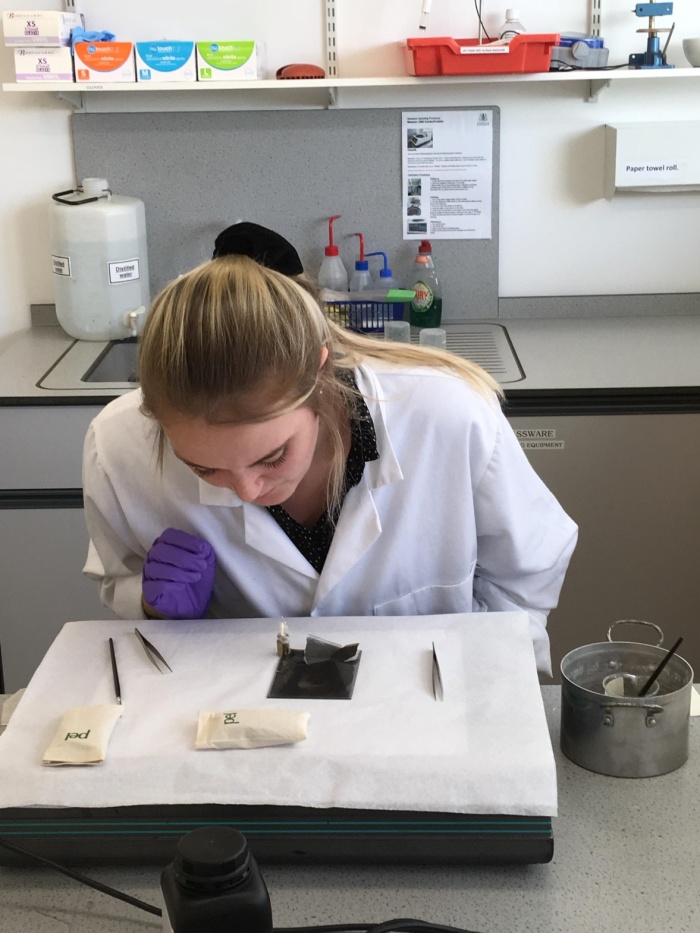A few weeks ago Sarah Allen, our wonderful conservator posted the first in a series of reports about the work she has been carrying out on our Glass Plate Negative collection. If you follow us on Facebook or Twitter you may be aware that Sarah has been able to effect a really exciting collaboration with the University of Lincoln, offering conservation undergraduate students the opportunity to work on our collection under the guidance of an experienced photographic conservation team, gaining valuable skills and work experience. This is great for the students but also wonderful for us as it means we are able to stabilise a far greater number of negatives within the time and budget we have available. Today’s contribution comes from Ellie Pearce, a student on Lincoln University’s Conservation course who is undertaking a placement on this project.
Ellie has kindly shared her experiences with us, including her favourite discovery in working with the plates, the prolific retouching that has been undertaken upon them. This is timely as it is a subject I recently spoke about to a local photographic group and will be covering in more detail in next month’s post.
In the meanwhile, over to Ellie, with thanks for all the ongoing work that she is doing on the collection.
My name is Eleanor Pearce and I am a Conservation and Restoration, (of historic objects) BA university student currently working on my work placement with Photographic Conservators Emma Bonson and Sarah Allen. I am almost at the end of my 6 week stint and will continue to volunteer working on the collection when my placement is completed.
 Working with a challenging negative
Working with a challenging negative
A large section of the treatment on the collection has been carried out at the University of Lincoln’s Conservation labs over the summer, and it will continue into the new University term. Students were given a valuable opportunity to clean, treat, document and rehouse these glass plate negatives. I saw this opportunity to work with Photographic materials so I immediately applied (having studied Photography at A-level I have always had an interest in Photography).
Nervousness and excitement were hand in hand the day I started the placement. I wasn’t 100% sure on what I had signed myself up for but I felt that the experience would be a beneficial one to me. The first treatment that Emma would show me was called a Flush Repair. A fresh piece of glass is placed on top of the emulsion side of the negative. It is then adhered together around the sides of the negative using a type of adhesive tape called p60 Filmoplast. A Flush Repair treatment may be necessary when the emulsion is peeling, there is a blind crack in the glass or a clean break from one side to another. Emma went through the process carefully and thoroughly. Then it was my time to carry out a Flush Repair it’s safe to say I was absolutely petrified. The emulsion on the negatives has been through a lot through the years, it is very thin and fragile and also it can be very unstable (as Sarah has mentioned in the previous blog post). I have been taught how to handle the objects in the correct manner, but once I held one of these plates I felt an immense sense of responsibility. As the days went by my confidence in handling and treating the photographic plates increased and my skill in identifying what treatments suited which negative improved.
When working on these artefacts one of the things that I find fascinating is what Emma likes to describe as ‘the old fashioned Photoshop’ techniques. This is when retouching paint or wax has been added to the non-emulsion side of the negative in order to create a certain type of effect. For example, some of the negatives have a wax coating on the back of them and certain areas are highlighted, such as the face by scratching some of the wax away from the glass. Another technique I have observed several times is when paint is added to the hair to give a more textured appearance. My favourite technique is when the person retouching the negative simply uses their fingers to apply the paint so their fingerprints are visible.
There was a cardboard adhered to this glass plate negative with black retouching paint around the edges. This would have been added to stop any of the background from being exposed.
Non emulsion side of glass plate negative highlighting some very fine retouching of the face.
Although I have still much to learn in the field of conservation of Photographic material (and conservation in general), I have developed valuable skills and gained knowledge that I will continue to use throughout my career as a Conservator. Emma and Sarah are both graduates of the University of Lincoln’s Masters Programme in Conservation and Restoration and are both working in their chosen specialism. One day I hope to be in a similar situation to them.
I am grateful to Emma and Sarah, for their patience and for sharing their invaluable knowledge and skills with me.












Fascinating insights into the work today of conservation and the art of the photographer in the past. More recently my children’s school photos offered different beautifying processes for different prices! I wonder if everyone was retouched in the past or just a lucky few? Good luck with your placement Ellie.
LikeLike
Thanks for your comment. Interestingly, almost all our plates are retouched to some degree. It certainly appears to be far more widespread then we were expecting.
LikeLiked by 1 person